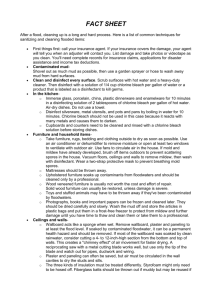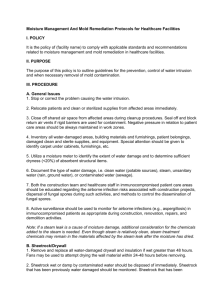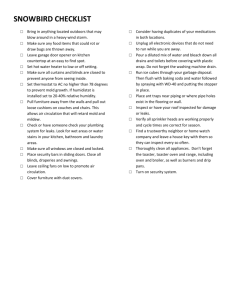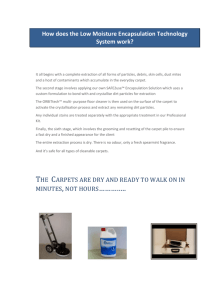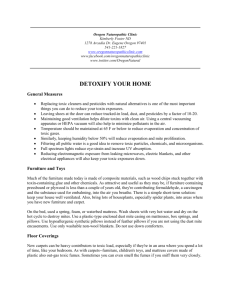Managing Water Infiltration into Buildings
advertisement
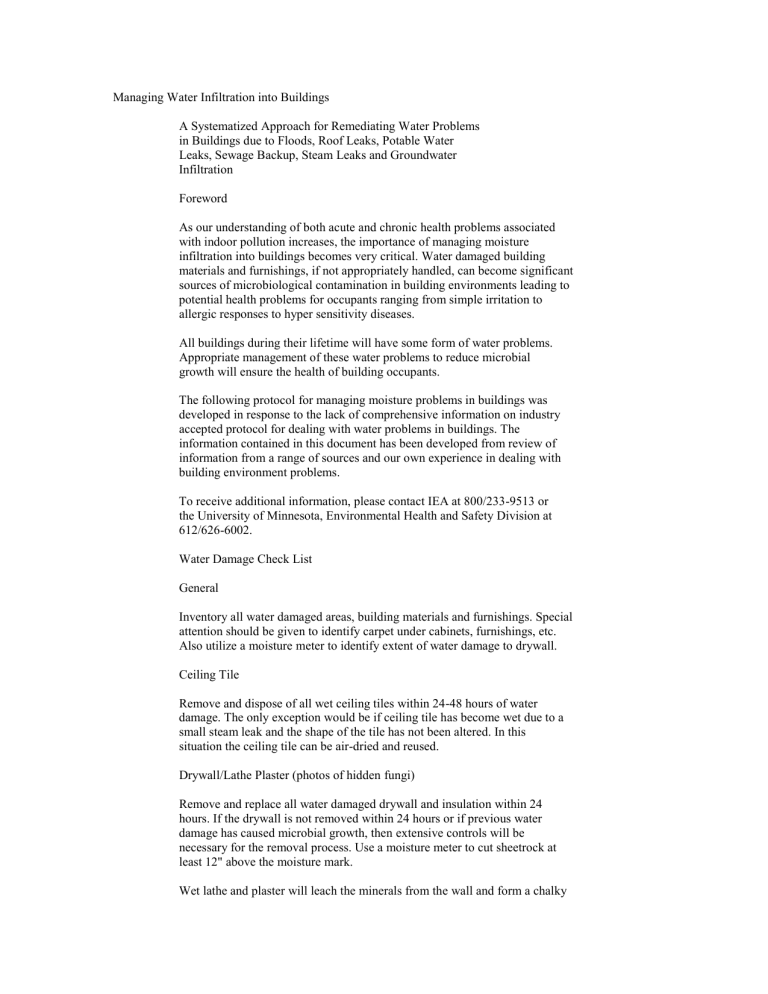
Managing Water Infiltration into Buildings A Systematized Approach for Remediating Water Problems in Buildings due to Floods, Roof Leaks, Potable Water Leaks, Sewage Backup, Steam Leaks and Groundwater Infiltration Foreword As our understanding of both acute and chronic health problems associated with indoor pollution increases, the importance of managing moisture infiltration into buildings becomes very critical. Water damaged building materials and furnishings, if not appropriately handled, can become significant sources of microbiological contamination in building environments leading to potential health problems for occupants ranging from simple irritation to allergic responses to hyper sensitivity diseases. All buildings during their lifetime will have some form of water problems. Appropriate management of these water problems to reduce microbial growth will ensure the health of building occupants. The following protocol for managing moisture problems in buildings was developed in response to the lack of comprehensive information on industry accepted protocol for dealing with water problems in buildings. The information contained in this document has been developed from review of information from a range of sources and our own experience in dealing with building environment problems. To receive additional information, please contact IEA at 800/233-9513 or the University of Minnesota, Environmental Health and Safety Division at 612/626-6002. Water Damage Check List General Inventory all water damaged areas, building materials and furnishings. Special attention should be given to identify carpet under cabinets, furnishings, etc. Also utilize a moisture meter to identify extent of water damage to drywall. Ceiling Tile Remove and dispose of all wet ceiling tiles within 24-48 hours of water damage. The only exception would be if ceiling tile has become wet due to a small steam leak and the shape of the tile has not been altered. In this situation the ceiling tile can be air-dried and reused. Drywall/Lathe Plaster (photos of hidden fungi) Remove and replace all water damaged drywall and insulation within 24 hours. If the drywall is not removed within 24 hours or if previous water damage has caused microbial growth, then extensive controls will be necessary for the removal process. Use a moisture meter to cut sheetrock at least 12" above the moisture mark. Wet lathe and plaster will leach the minerals from the wall and form a chalky surface. The loose material on the surface will need to be removed under controlled conditions and the surface allowed to dry. The surface can be painted with an antimicrobial paint. If the plaster/lathe wall develops a strong odor, with or without visible mold growth, remove people from this area of the building. Eliminate the source of the water and replace the water damaged plaster. These controls include set up of critical barriers, negative air, appropriate respiratory protection for the workers, gloves and disposable coveralls. Excellent personal hygiene, including hand washing and showering after work in the area is also recommended. All hard surfaces such as block walls etc. should be scrubbed with a mild detergent followed by a rinse of the surface using a solution of 1/4 to 1/2 cup bleach per gallon of water. DO NOT follow this with a clear water rinse since it is desirable for the bleach to remain. After work is completed, turn the heat UP and utilize dehumidifier to dry the area. CAUTION: The chlorine in the bleach may cause corrosion, therefore avoid using on metal surfaces. Instead use the aforementioned cleaning procedure with only a wash with a mild detergent. Also, bleach may fade colors. Therefore, test the bleach solution in an inconspicuous location before proceeding. USE BLEACH IN A WELL VENTILATED AREA. DO NOT MIX BLEACH WITH OTHER CLEANING CHEMICALS, ESPECIALLY THOSE CONTAINING AMMONIA. POISONOUS VAPORS WILL RESULT. Electrical Consider all wet wiring, light fixtures, electrical outlets to be shock hazards until it has be checked by a building inspector and/or electrician. Until then, turn the power off in the area of the water damage. [Note: Only persons knowledgeable about electrical shock hazards should shut the power off.] All electric circuit breakers, GFIs (Ground Fault Interrupters) and fuses that have become wet need replacing. Switches and outlets that were wet can be cleaned and reused but, when in doubt, replace them. All electrical motors, light fixtures, etc. that were wet need to be opened, cleaned and air-dried by a qualified person. Before being put back into service, inspect the motors, light fixtures, etc. to ensure no visible moisture/water droplets. Furniture Upholstered furniture that has become wet due to floods, roof leaks, sewage backup and ground water infiltration should be disposed. Upholstered furniture damaged by steam leaks or direct contact with drinking water should be dried within 24 hours and monitored for fungal growth and odors. Hardwood furniture of laminate furniture whose laminate is intact should be air dried and cleaned with a solution of 1/4 to 1/2 cup bleach per gallon of water. See caution statements in #3 above. Laminate furniture whose laminate has become delaminated should be disposed of because the pressed wood under the laminate absorbs water readily and is hard to dry. Furniture made of particle board or pressed wafer board should be discarded. The exception would be if the furniture has become wet due to a steam leak. In this situation, the furniture can be dried and monitored closely for fungal growth/odor. If fungal growth occurs or the furniture develops an odor, the particle board/pressed wood furniture should be discarded. Files/Papers Remove and dispose of non-essential wet files and paperwork. The exception again would be if the moisture was due to steam leaks; then these can be dried. Essential wet paper from water damaged area should be moved to a location where it can be dried, photocopied and then discarded. Professional conservators should be contacted for information on handling these types of wet products: American Institute of Conservation 202/452-9545, fax 202/452-9328. If large amounts of files and paperwork cannot be dried within 24-48 hours, essential files/paperwork may be rinsed with clean water and temporarily frozen until proper drying can be completed. Any paper products that do develop mold will need to be discarded. Carpet Any carpet that has been contaminated over a large area with sewage backup should be discarded under controlled conditions and the entire area disinfected with bleach and water. Small areas of carpet contaminated with sewage backup may be cleaned using the procedure listed for other sources of water. Carpet that has become wet from floods, roof leaks, steam leaks, potable water leaks and ground water can be treated as per the following: Carpet Wet LESS THAN 48 HOURS: Remove all materials (e.g. furniture, file cabinets) from the carpet. Extract as much water as possible from the carpet using wet vacuums. Shampoo the carpet with a dilute surfactant. Soak with a 1/4 to 1/2 cup bleach/water solution. Maximum concentration: a solution of 1 part bleach to 10 parts water. (see bleach caution in #3 above) It is preferable not to use a biocide. If a decision is made to use a biocide consult a microbiologists. Reason: People may have reaction to biocides. Often quaternary amine compounds will be used as a biocide/cleaning compound. The compound may reduce levels of bacteria but is often ineffective in killing fungal spores. Rinse and extract the carpet with clean water to remove detergent/bleach residues. Commercial steam cleaning of carpeting can be used in place of bleach. The vacuum system is housed in a truck. The water is heated above the boiling point and is used to clean the carpeting. Dry the carpet within 12-24 hours of treatment. After work is completed, increase the room temperature, and use commercial dehumidifiers, floor fans or exhaust fans to aid in drying the carpet. Carpet Wet MORE THAN 48 Hours: Wintertime: If carpet becomes wet during the winter with relatively clean water, the previous protocol can be used to manage the carpet and salvage it. Summertime: Drying carpeting is usually more difficult in the summertime than the winter if the carpeting is not in an airconditioned space or dehumidifiers are not available. Water damaged carpets in humid environments often do not dry adequately. Disposal of water damaged carpets in humid environments is often the best option. Testing If visible mold reappears or area smells of mold, the treating process (cleaning and bleaching) should be repeated. Testing should be considered if there are continuing complaints from the occupants of the space, or there is a concern about lack of successful prevention activities. Post cleanup clearance sampling and inspection by a trained environmental health professional is useful to ensure no excessive concentration of microbes will exist in the building. Areas that are harder to access for cleaning should be specifically tested and any areas of carpet that had material on top should be tested. If the carpet develops an odor or visible mold growth is apparent, the carpeting will need to be removed under controlled conditions. If mold sensitive persons react when entering a space with previously water damaged carpet, with no odor or visible mold growth, the carpet should be tested or discarded under controlled conditions. Exception to the testing would be materials that had moisture infiltration for the first time and are being discarded. Note on Personal Protective Equipment If testing has confirmed microbial growth on previously wet materials, then appropriately trained personnel with appropriate respiratory and personnel protection should be used. Negative air enclosures may also be set up for limiting cross-contamination from damaged areas. Inventory all water damaged building materials and furnishings. Sheetrock If within 24 hours and no previous water damage: remove and discard with minimum controls.If after 24 hours or previous water damage: remove and discard under controlled abatement conditions. Ceiling Tile If steam damage: air-dry and reuse and monitor for future mold growth. If other water damage: remove and dispose within 24 hours. Electrical Have checked by building inspector/electrician. Turn power off, and Discard electrical circuit breakers, GFIs, fuses, and Switches, outlets, electrical motors, light fixtures can be opened & inspected for visible moisture and re-used. If in doubt, throw it out. Furniture Upholstered steam or drinking water: air dry and monitor. If other water damage: discard. Hardwood or Intact Laminate Appropriately cleaned. Particleboard/Pressed Waferboard If steam: air dry and monitor. other water damage: discard. Delaminated Furniture/Cabinets If steam: air dry and monitor. If other water damage: discard. Carpet If wet for less than 48 hours: follow procedure #7 to clean and disinfect. If wet for more than 48 hours: If winter: disinfect and dry. Discard if cannot dry. If summer (high humidity): discard. Paper/Files If non-essential: remove and dispose. If essential: dry within 24-48 hours. If cannot dry within 24-48 hours: clean with water and freeze, then contact American Conservation.
